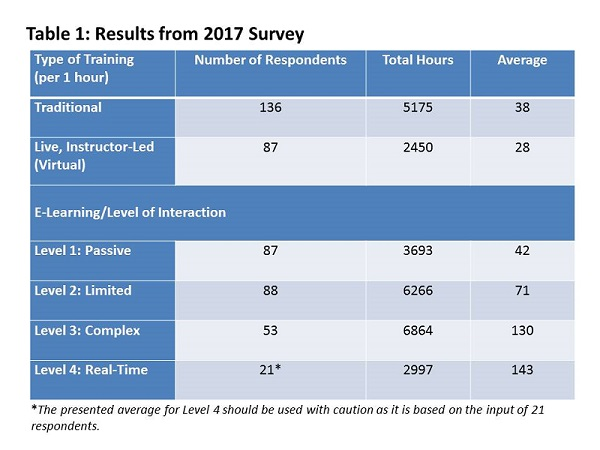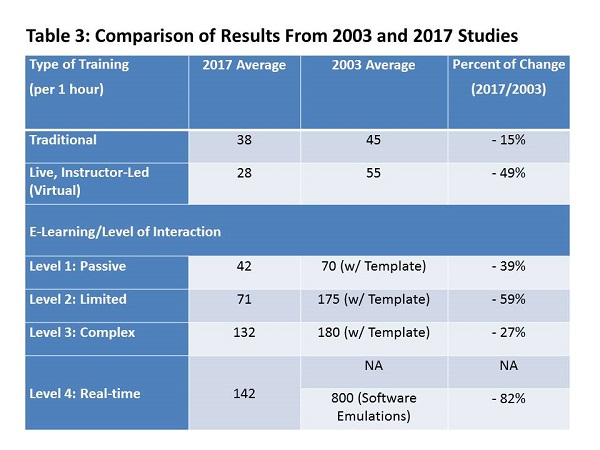ATD Blog
How Long to Develop One Hour of Training? Updated for 2017
Tue Jan 09 2018

Sign up for the Instructional Design Newsletter!
This article is an update to a study that tried to answer the question: How long it takes to design one hour of instruction? It presents a comparison of findings from 2003, 2009, and 2017.
It’s hard to believe that it has been roughly 14 years since Dr. Karl Kapp first tried to address the question: How long does it take to develop one hour of employee training?
In 2009, as innovations in authoring tools and simulated learning started to permeate the market, it became clear that L&D professionals needed new answers to this fundamental question. Karl and I gladly took to that request and expanded the understanding of developmental hours and common challenges practitioners face when producing training. (See the 2009 article.)
Clearly, this is a compelling line of inquiry that remains a constant in our industry. What’s more, maybe it’s our field’s propensity to create order from chaos that we continue to pose the question. No matter the reason, I was excited to reprise this research with the help of ATD to present the most current findings based on levels of engagement.
In this article, we will explore the results from a 2017 survey, compare that data to the previous two studies, and discuss a few trends that have emerged over the years. If you are unfamiliar with the research, the data helps to squelch the desire to say, “It depends…” when a client asks how long it will take to develop employee training. These numbers provide another way for project planners to budget time, money, and resources, and they can be used in place of or in conjunction with estimates based on old projects with similar needs. At a minimum, it provides a method for making estimates, comparisons, or both.
The 2017 Study
To conduct the current study, the questions from the last two studies were examined, as well as trends in how industry professionals are discussing the development of employee training. For instance, learner engagement or level of designed interaction appears to be framing the current discourse. Consequently, the 2017 survey only covers levels of interaction, whereas the previous survey asked about development tools and levels of interaction based on the ADDIE model. The new survey also did not reprise the line of inquiry on template use within development.
Respondents to the 2017 study were presented two questions. The first question identified what types of training respondents were involved with, from a design and development aspect. The second question asked respondent to share how long it typically takes them or their teams to design and develop one hour of instruction. The term e-learning was defined as asynchronous and self-paced for purposes of this study.
With the survey updated, ATD reached out to L&D practitioners to gather data over a few weeks during the summer of 2017. Three-quarters of respondents (76 percent) indicated they are involved in designing and developing traditional live in-person classroom training. Almost half of respondents (49 percent) stated they are involved with live instructor-led synchronous training delivered virtually.
Some additional data includes:
49 percent design and develop Level 1 E-Learning. This is passive e-learning where the learner acts simply as a receiver of information.
49 percent are involved with Level 2 E-learning. This is defined as limited interactivity, with the learner offering simple responses to instructional cues.
29 percent say that they or their team design and develop Level 3 E-Learning. This level has complex interactions that requests the learner to make multiple and varied responses to cues.
12 percent of respondents or their teams are involved with Level 4 E-learning. These real-time interactions create life-like sets of complex cues and responses.
Table 1 details the 2017 findings.

In 2009, we acknowledged an increase in training and development hours compared to 2003 data. For the 2009 study, we expanded the set of questions in an attempt to create a profile of respondents. In addition, the development time was discussed in conjunction to the ADDIE model, but also to the type of development tool being used. Finally, the study also considered whether training was being developed with the aid of a template.
Table 2 summarizes the averages from the 2017 study in comparison to 2009 averages (Levels 1-3 only).

Table 3 compares 2017 and 2003 data. Again, the averages used from 2003 were based on development estimates that used a template (Levels 1 – 3 only).

It’s worth noting that many responses to the 2017 study still cite the prevalence of traditional, face-to-face learning. Additionally, a majority of respondents reported a preference for live, virtual training. This tells me that even though we are reducing the overall time to develop training, respondents are still catering to clients who seek training solutions that offer potentially “limited interactions” that are seen in Level 2 E-Learning. My reason for stating “potentially” is that both the traditional, face-to-face training and live, virtual training may have elements that are considered complex or real-time; for example, a team-based exercise resolving conflict or simulating an emergency, and so forth. No doubt, this requires further study.
Unknown Factors Impact Development Time
So why did hours over the years go up and then down as we look at data from 2003 through 2017?
A likely influencing factor is that we broke up the survey differently in 2009 and asked for more information from respondents. For example, in 2009, we discovered that subject matter experts and project scope appeared to have the largest effect on the estimates provided by respondents. In 2017, the purpose of the study was to update such estimates.
However, to better approximate development times in the future, it would be important to gain insight into how individual respondents determined their time estimates. For example, it would be useful to know how many years of experience respondents have and whether they have specialized skills (UX design) or are more general practitioners (project manager, instructional designer, and developer). Further, what type of domains (cognitive or affective, for instance) have they developed learning products for in their organizations?
It also would be helpful to know the environment of the developers. Do they work for a vendor or are they part of an internal team that develops learning products in-house? In addition, do they specialize in certain types of interaction? For example, a respondent who works for a vendor that focuses on the development of Level 3 and 4 training products may report lower development times because the company has more than likely created efficient processes for design and development.
Of course, we cannot forget about the importance of the actual technology. What type of authoring tool is being used to develop? Is it up-to-date or antiquated? Does the training solution involve some sort of technology that requires implementation and partnership with IT?
Finally, it may be important to know who the client is. What is the client’s influence and input? Do they understand their role in the development process? If not, their involvement can lead to project scope creep and an increase in development hours.
Bottom Line
I conclude, as will many L&D professionals, that “one hour of employee training” is not the sole answer to our needs. But it can provide a useful tool for guiding how we manage learning development. Although the 2017 data denote a trend for e-learning with limited interactions, such options may not be optimal as the demand for training on soft skill topics increases—probably in response to the growing cross-generational workforce. In fact, such topics as team collaboration, business communication, and active listening are becoming principal needs for organizations. These are ideal opportunities for not only in-person or virtual training, but also Level 4 e-learning interactions.
In truth, the data we do have is helpful as a gauge for estimating training and development times. But until further research is done to correlate the respondent’s professional profile, a general summary of the development process, and the type of learning content being developed, we are a going to continue to have this discussion about how long it takes to develop e-learning! (Although, I think many of us actually enjoy the discourse! So, if you want to keep the discussion going, please share your thoughts in the comments below.)
For more on this topic, see How Long to Develop One Hour of Training: A Case Study.
Check out similar articles: Writing Effective Case Studies
var url = “https://www.td.org/insights/how-long-does-it-take-to-develop-training-new-question-new-answers”; location.href = url;
